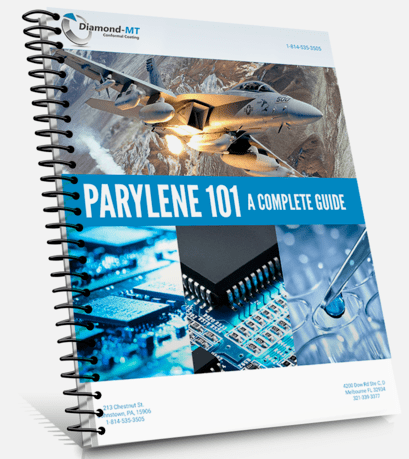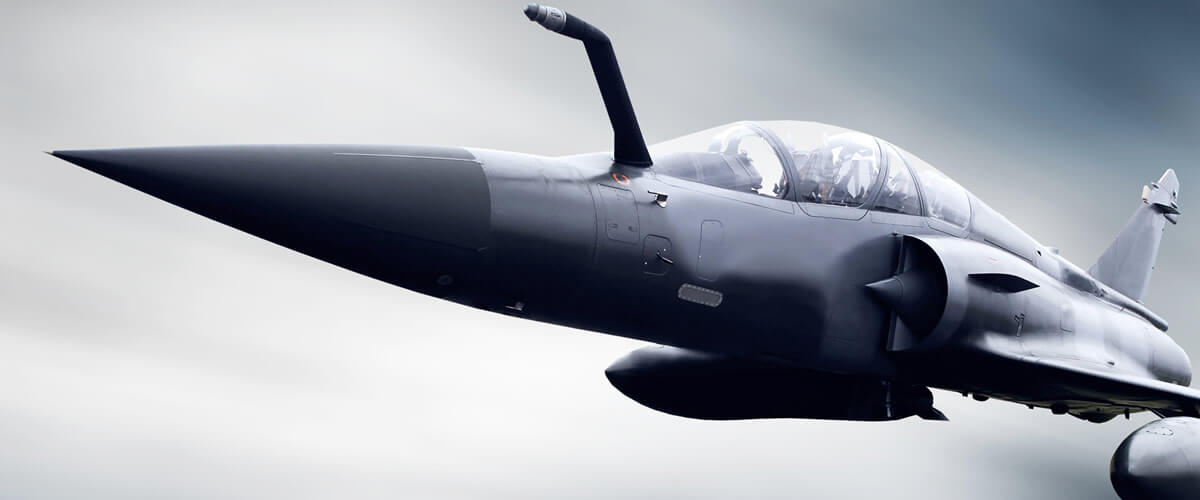
There are many different facets to conformal coating, from equipment and applications to the different types of coatings. Conformal coating is a protective, nonconductive, dielectric layer that is applied onto the printed circuit board (PCB) assembly to protect the electronic assembly from damage due to contamination, salt spray, moisture, fungus, dust and corrosion caused by harsh or extreme environments.
Conformal coatings are usually used in products that are made for use in outdoor environments where heat and moisture are prevalent. Coating also prevents damage from rough handling, installation and reduction of mechanical and thermal stresses. Read on for more information about the conformal coating solutions at Diamond MT or contact us today to begin your project.
Conformal coatings are very thin layers of material designed to protect the surface of sensitive electronic components. These layers are applied onto the substrate and act as a protective coating, using their chemical properties to protect the inner circuitry from harsh elements and wrap and conform to the exact shape of the parts. Conformal coating is used when the finished product is exposed to a harsh environment. These environments may include heat, chemicals, moisture or any element that could damage the mechanics of a printed circuit or the substrate.
Conformal coating started as a simple process performed on electronic substrates in need of extra protection from external elements, with little attention paid to quality factors beyond adequate component coverage. The increased capability of semiconductor assemblies to perform complex tasks in automotive applications, traffic control, signage, outdoor surveillance and mission-critical elements has increased the demand for conformal coating. Because device failure could have dire consequences, the quality of coating material application is critical.
New equipment and processes are in place to accommodate the conformal coating requirements of these emerging technologies. A smooth transition to automated precision conformal coating can be achieved through an analysis of the product being coated and the desired result, the coating material used, the process selected and the economic costs over a period of time.
Diamond MT offers five types of conformal coatings:
After the coating process is complete, the coating is clearly visible as a clear and shiny material. Some coatings are hard, while others have a slightly rubbery texture. Conformal coatings are also as thin as a few micrometers, offering comprehensive protection without the bulk. Most coatings include a marker that appears greenish-white when viewed under UV light. This marker enables easy inspection of the coating thoroughness checking during production.
You can select the best conformal coating option based upon a couple of factors, such as the intended application. For example, devices used outside need moisture and vapor protection, coatings on medical devices need to be biocompatible and electronic power applications require anti-corrosive coatings. You should also consider your business needs, or what you expect from your coating, such as market pricing or longevity.
In the past, coatings were only applied to military and life or medical products as the cost and the process was significantly higher per unit. In recent years, the development of materials and new processes has enabled a larger variety of items to be coated, including a wide array of consumer electronic products. As prices continue to drop, conformal coating will become increasingly common for circuitry and electronic components, especially as these items continue to shrink in size and dimension.
Conformal coatings are used in the Internet of Things (IoT), military, industrial and automotive fields to protect machinery and electronic devices from harsh conditions, so they can stay functional. Different conformal coating types, such as acrylic conformal coating, urethane conformal coating and silicone conformal coatings, are frequently used in conjunction with different conformal coating systems to apply the coatings in a quick, easy manner for larger-scale production.

Conformal coating has several advantages, which is why it's so common. These benefits include:
Conformal coating thickness can be critical to the proper function of a printed wiring assembly (PWA). If a coating is too thin, proper coverage is impossible. If a coating is too thick, it may create excessive stresses on solder joints and components (particularly glass-bodied components). Controlling coating thickness is of special importance with rigid coating materials (e.g., epoxies and some of the urethanes) because the residual stresses associated with an excessively thick application of these materials are much greater than with flexible coating materials (such as silicones and some urethanes).
Conformal coating thickness requirements are in accordance with the Institute of Printed Circuits (IPC) J-STD-001 for the following coating types:
| Type AR | Acrylic Resin | 0.00118 to 0.00512 in |
| Type ER | Epoxy Resin | 0.00118 to 0.00512 in |
| Type UR | Urethane Resin | 0.00118 to 0.00512 in |
| Type SR | Silicone Resin | 0.00197 to 0.00827 in |
| Type XY | Parylene Resin | 0.000394 to 0.00197 in |
Additionally, conformal coating thickness is measured on a flat, unencumbered, cured surface of the printed circuit assembly or a coupon that had been processed with the assembly. Coupons may be of the same type of material as the printed board or may be of a nonporous material, such as metal or glass.
Conformal coating thickness and coverage shall have the following characteristics to ensure that coating thickness specifications are upheld:
We hope we have provided a good description of the different types of conformal coating and our conformal coating services. If you have further questions, please contact us, and we'll be a good resource for you. You may also contact us online to request a quote for your order.
Diamond MT has provided conformal coating services in Pennsylvania and Florida since 2006. Our history in the industry and many certifications make us the thought leader in conformal coatings. We offer many conformal coating solutions, including:
Diamond MT has multiple conformal application methods. We will use the technique that works best with your coating type, final result specifications and order size.
The dipping process is the most common application method. It can be done typically by automated equipment or manual application. The PCBs or other electronic components are typically hung by an arm and then lowered in a dip tank containing the coating. The immersion rate is determined by the population density of the PCB to be dipped.
Some advantages of this process are coating penetration under components, assured coating thickness, fast process time and low skill process in application. Some disadvantages of dip coating are thin tip coverage, inconsistent coating thickness and rather intensive required masking.
Spray coating is the second most widely used and accepted application of liquid conformal coatings. In this process, the material is diluted and sprayed onto the device using an aerosol can or spray gun. It requires multiple passes, each at a 45-degree angle with multiple coats to achieve the desired thickness.
Advantages for spray coating are a high production volume capable of thousands of boards per week, reduced masking in comparison to the dip method, good tip and edge coverage and a more uniform thickness. Some disadvantages are that multiple passes are needed to achieve the desired thickness, and there is less penetration of coating under components in comparison to dipping.
Brush coating application is commonly used with a low volume production run. During this process, it is important to keep the brush loaded with coating and let it flow — do not paint the assembly.
The primary advantage of this process is the extremely low cost. It is well suited for low-volume applications as well as repair and rework of an assembly. Disadvantages are its slowness and labor-intensiveness on large board, which also makes for a questionable finish for the assembly.
Selective spray coating application is very common amongst automotive and other high volume applications in which board design and layout does not change much over long periods of time. For this application, selective spay maximizes throughput by minimizing the amount of masking as well as providing a highly controlled process, creating precise repeatability.
However, there are some disadvantages to this process. Boards may still require masking, and it does require a skilled operator to program and operate this machine. Programming is time-consuming as well, in addition to the high cost of the spray machines.
For existing coatings that are damaged, impaired or otherwise not providing adequate protection, we will rework and repair your coatings to restore their condition. We perform these tasks per IPC-7711 and IPC-7721 specifications. These certifications mean we use industry-approved rework and repair techniques for electronic assemblies and PCBs.
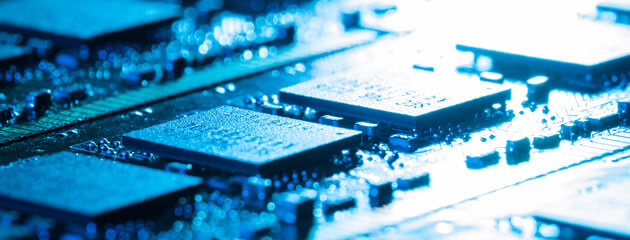
It is important to consider how the choice of a conformal coating material affects the rework and repair issues. The need for rework or repair of a conformal coating can arise at any time after completion of an assembly due to a variety of process or product requirements or component replacement issues. Hence, rework of conformal coatings needs to be addressed up front when choosing a coating chemistry.
The thermal removal method using a soldering iron is the least recommended method. Most conformal coatings require a very high temperature and long exposure times. These requirements, in turn, can cause discoloration, leave residues and adversely affect solder joints and other materials or components used in the fabrication of assemblies.
The process must be monitored to ensure that excessive temperatures do not cause delamination, lift pads or overheat surrounding temperature-sensitive devices. Extreme caution must be taken when burning RT conformal coating because some coatings emit toxic vapors, which are hazardous.
Chemical methods are the most popular for the removal of conformal coatings. As long as the solvents used do not adversely affect the printed wiring board (PWB) or components, and there are no environmental issues, this technique works well. However, there is no one perfect solvent for all applications, and in some cases, it may be difficult to find a suitable solvent.
The following sections discuss the chemical removal methods for various types of coating:
Urethane
There are several solvents which provide a wide range of speed and selectivity that can be matched to a specific application. These solvents include:
Silicone
Methylene chloride-based systems are very effective in removing silicone conformal coatings. Several hydrocarbon-based solvents are also used as alternatives. While not as fast as the methylene chloride, the hydrocarbon based solvents are more selective, and where not contaminated by water, will not attack epoxy-glass PCBs, components, metals and plastics.
Acrylic
The chemical removal of acrylic coatings was done in the past with highly volatile and flammable solvents such as methylene chloride, trichloroethane or ketones. A relatively safe alternative based on butyrolactone has been used for the removal of most of the acrylic coatings.
Epoxy
The complete removal of epoxy coatings for repair is nearly impossible by chemical means. The solvent can’t discriminate between the epoxy coating, epoxy-glass PCB and any epoxy-coated or potted components. However, if done carefully, spot removal may be accomplished by the application of methylene chloride and an acid activator with a cotton-tipped swab.
Diamond MT can provide both standard and custom boot solutions for a customer, depending on their needs. We have a wide range of custom boots and designs in stock and ready to manufacture. We can quickly match these to your needs or help develop a custom solution through our design services to help you get the protection you need in your conformal coating process.
Masking boots are an integral part of a full masking solution in coating applications for printed circuit cards, whether this is for a liquid conformal coating process or a vapor deposition process such as parylene. Many components and parts on a printed circuit board must remain uncoated from conformal coating.
The purpose of the masking boots is to provide easy-to-use covers instead of alternative materials, such as masking tape and tape dots to prevent coatings from going in the wrong areas. Conformal coating masking boots come in all shapes and forms to protect different types of components for all conformal coating application techniques.
The purpose of masking prior to conformal coating an assembly is to keep the coating from being applied to areas that would not be able to perform properly with it. Masking is often the most critical and thus the most meticulous and time-consuming aspect of the conformal coating process.
Failure to properly mask could result in the improper coating, hindering the performance of the technology, or worse, completely ruining the assembly. Our technicians are specially trained to ensure proper masking of your assemblies so you have peace of mind that your product will be returned to you without issues, imperfections or defects.
The masking process begins with proper, effective communication with our customers. Detailed drawings are obtained that identify the “coating-free” areas. If these areas are not properly identified early on in the procedure, it can lead to improper coating and increased cost. If you are not familiar with the masking or conformal coating process, we are willing to work with you, following standardized and customer-driven specifications to develop a masking process to suit your needs.
The masking process continues with our team developing working instructions for our production personnel to follow. Once production has completed masking your assemblies, our quality assurance team performs a 100% inspection to ensure that the end result is in complete compliance with your coating requirements.
The typical boots can be divided into two types:

The typical boots can be divided into two types: A and C type Cups.
A Cups are boots which cover vertical connectors and components and are the simplest form. These include covers for d type and molex connectors.
C cups are boots which cover horizontal connectors and wrap around the component from both sides of the board in general. these tend to be more complex in design although we can provide both standard and custom boots solutions for a customer depending on their needs.
A Cup
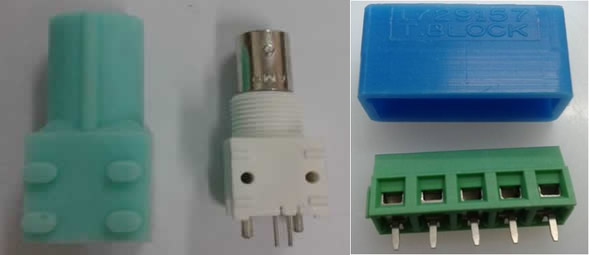
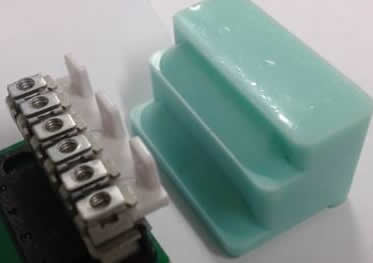
C Cup
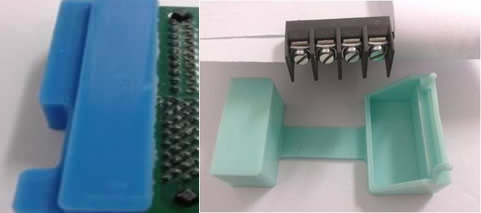
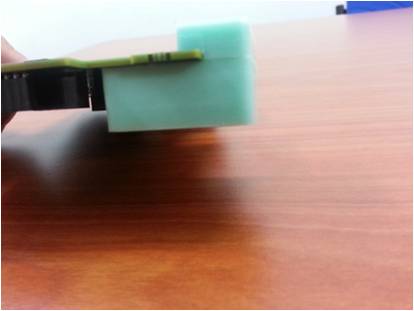
Diamond MT provides a full range of conformal coating application equipment and conformal coating systems for those looking to bring the conformal coating process in-house. Please explore our list of products below to find the perfect piece of equipment for your specific needs!
Diamond MT can help you discover the best equipment solutions for your specific needs. We work with you to ensure that you are getting the most cost-effective solution for your product, whether that is parylene coating solutions, bringing equipment in house or another type of conformal coating.
Selective coating is a more recent development among conformal coating methods. Selective coating combines the advantages of several coating methods into a single coating method. There are several types of coating applicators. Spray coating is an atomized process that can achieve a thinner film pass. However, if selectivity is a requirement, the applicator usually has to move more slowly. The finish is a feathered or fuzzy coating on the edges.
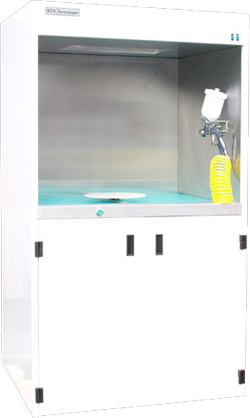
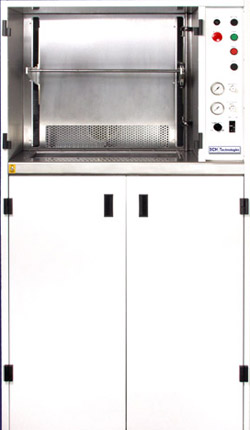
Automated dip coating is one of the most efficient methods for application of conformal coating and is excellent for all volume production, whether large or small. The process of dipping a circuit board in a conformal coating material contained in a tank ensures complete coverage, including underneath components and around difficult later 3D boards, and there is no overspray or material wastage.
We utilize a variety of high volume low pressure (HVLP) spray guns for our hand spraying process, in addition to multiple spray booths. This method is ideal for customers with small to medium quantities. Additionally, this method is preferred with customers who have tall components or a geographical layout that does not lend itself to a programmable conformal coating method.
